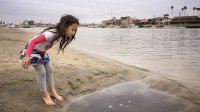Using Nature to Engage Students in Learning
Nature comes in all shapes and sizes—from a park to a potted plant—and teachers can use it to spark learning and build a classroom community.
Your content has been saved!
Go to My Saved Content.As a kindergarten teacher, I’ve been at the front lines of pandemic schooling, which has prompted my team to reimagine how we foster joy and relationships with our students. As we reflected upon our deepest values and commitments, we remembered that nature is all around us and can be a fabulous platform for learning in and out of the school building. I’ve always been passionate about nature’s role in education, and teaching during the pandemic has shown me just how joyful—and necessary—teaching with nature can be.
My team and I use nature to wake up our students’ imaginations, friendships, and interest in stories. We have encouraged our students to go on nature walks with their families during asynchronous learning and to find “nature treasures” such as leaves, sticks, and shells. These treasures spark their imaginations and hold stories that they want to share with their friends.
Getting Started
Upon our return to the classroom, we plan to take nature walks together in the fields near our school building, but one of the main tenets of our approach to using nature for learning is that nature can be anything—a potted plant, fresh herbs for cooking, trees outside the window, ants on the driveway.
We seek to reimagine what counts as nature as we work toward a more inclusive, antiracist, and decolonizing classroom. Our school is a Title I campus, which means that more than 40 percent of our school population qualifies for free or reduced lunch. Access to green spaces and natural areas is limited for some of our students. Likewise, many schools do not have access to natural spaces or parks. However, all students can engage in some form of natural exploration, and we see it as part of our job to support them in doing so.
Our essential questions are: How do I connect with nature? How does nature connect me with others? What do I love about myself? What do I love about nature?
As teachers, we regularly come back to these questions and seek to expand our imaginations about the possible answers to these questions. Does a student have a pet fish? That’s nature. Does a student love to eat vegetables from their grandfather’s garden? That’s nature too.
Building Connections
Using nature as a shared foundation helps children build relationships with one another. We invite them to present to the class about their nature adventures with their friends and families, and guide them to write stories about their adventures in their nature journals. Every day during our morning meeting, children share their experiences in nature with one another. They discover what they have in common and compare nature treasures that they found.
We’ve seen firsthand that these activities build connections, empathy, and curiosity in our learners. Even while exploring nature independently, students find the same species of trees, plants, animals, bugs, and other flora and fauna common in our region. This is the springboard for our class conversations about how we are similar and different, and these conversations foster key social and emotional skills including relationship-building, empathy, and listening.
We go on weekly virtual field trips as a class to explore nature near and far. Some of our favorite virtual field trips have been to the San Diego Zoo and the Monterey Bay Aquarium, and we like the live cams at Explore.org. These organizations offer high-quality live cams of animals and plants that are fun to explore. When we return to in- person learning, we’ll continue to use these virtual field trips to contextualize our learning and to learn more about nature far away from us.
Literacy and Math
My team and I use these experiences exploring nature as the basis for our literacy instruction, with a play-based, Reggio-inspired approach to learning. For example, we use the “story workshop” approach from the Opal School in Oregon, which integrates play and the arts into literacy and writing. As part of our nature-inspired story workshop, we provide children with natural materials such as leaves, rocks, sticks, and bugs to provoke their curiosity and imaginations, and to guide their writing. Children learn to sound out words that are relevant to their nature escapades (e.g., sun or tree). They draw and label pictures to tell a story about their experiences in nature, and write sentences to go with their drawings.
Nature also serves as the foundation for our mathematics instruction, creating a shared context. In kindergarten, math is mostly about cardinality (counting) and basic geometry, so we might ask students to find a counting collection from nature, like a collection of 10 rocks. Or we’ll ask them to go on a nature walk and draw what shapes they see. Finally, we look for patterns in nature: animal and plant patterns, as well as abiotic patterns in rocks or water. In these ways nature serves as foundational math instruction and acts as a shared context and shared set of resources for lessons.
I’ve found several resources instrumental in my journey toward nature-inspired education. I’m a National Geographic–certified educator, and I highly recommend their free, online course to any educator interested in learning more about incorporating nature into the classroom. I also suggest looking for professional development courses in your area that support educators in teaching outside in the natural environment.
Nature is everywhere and can be a fabulous vehicle for learning both inside and outside of the classroom.
